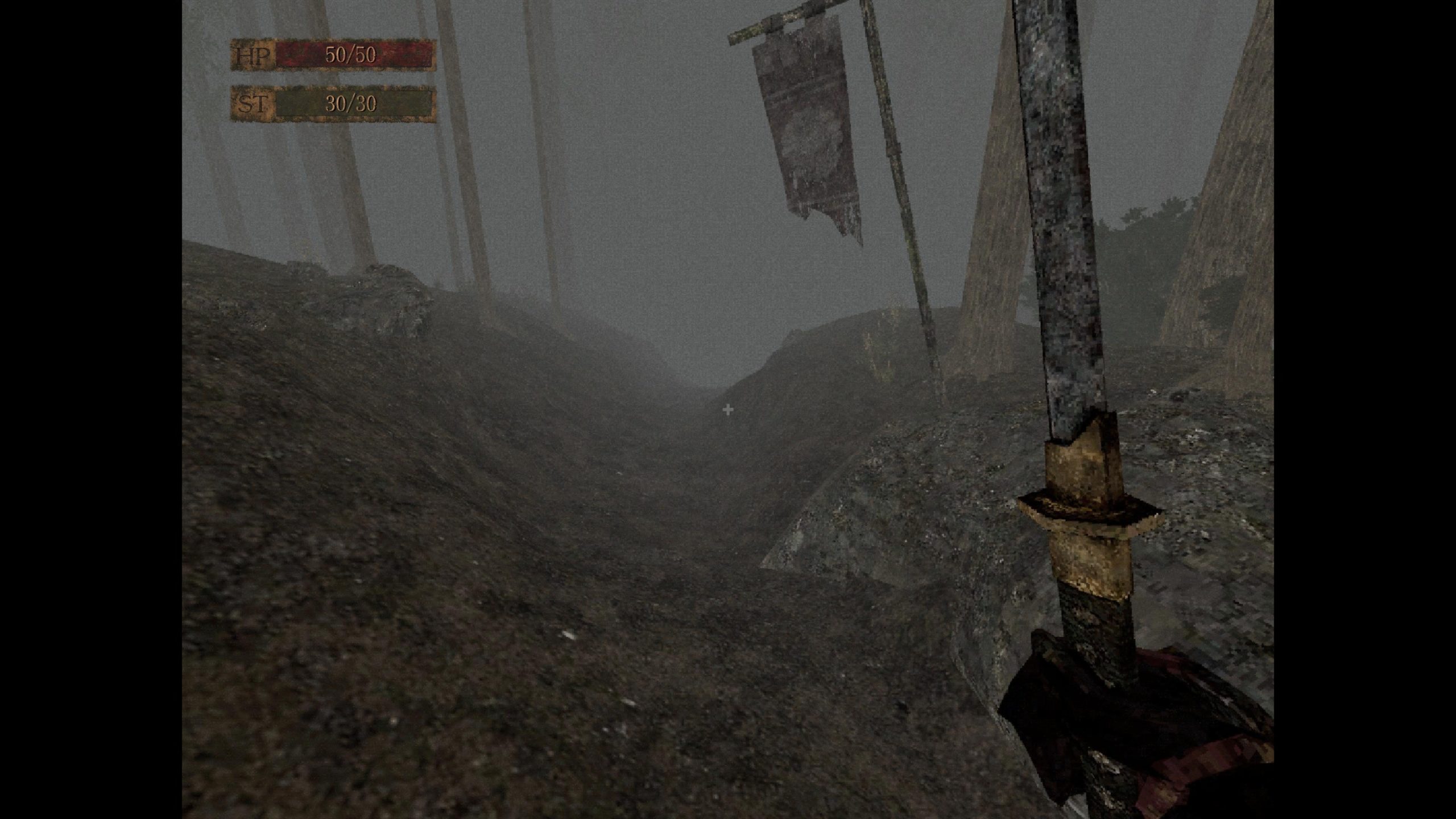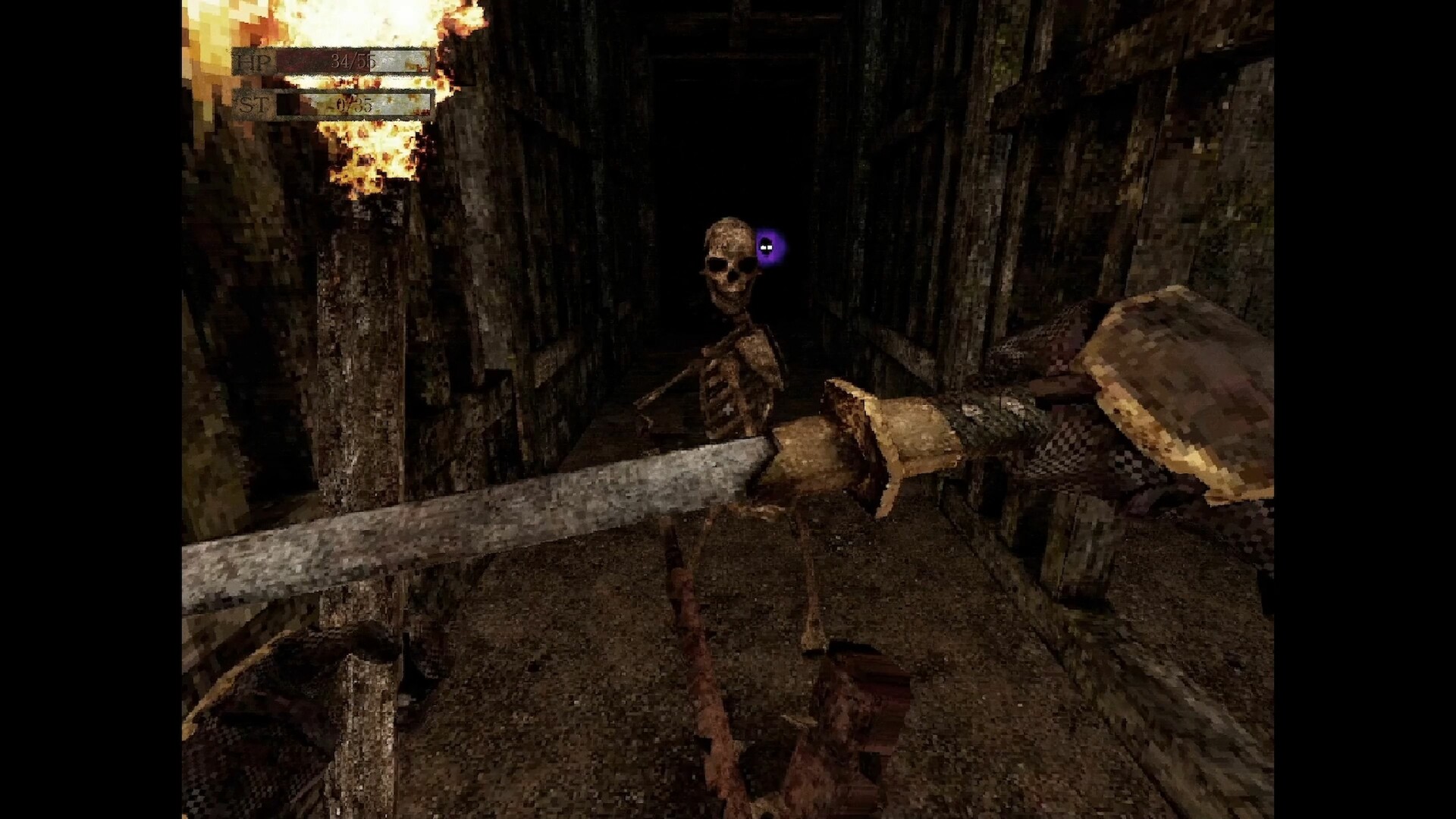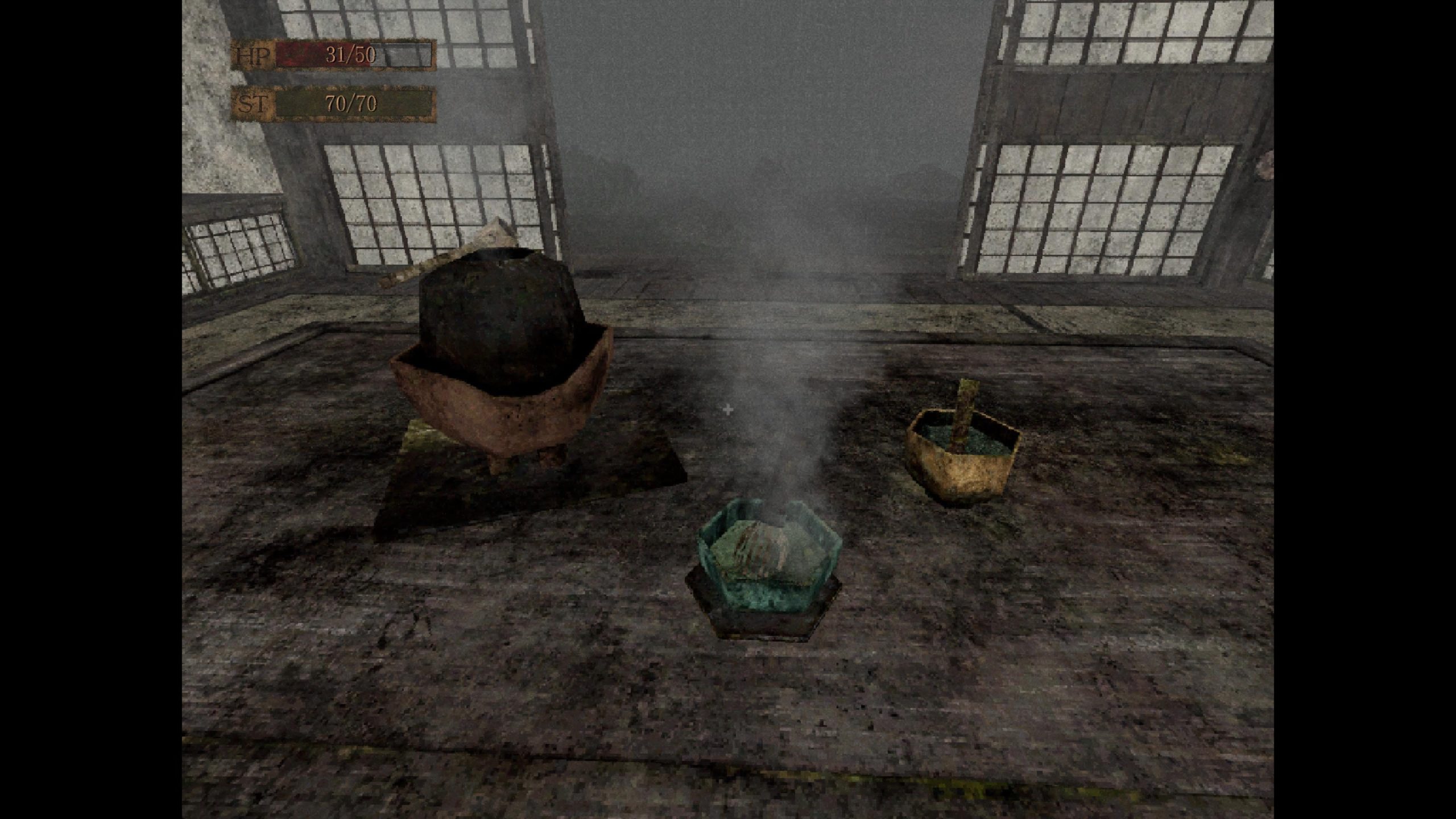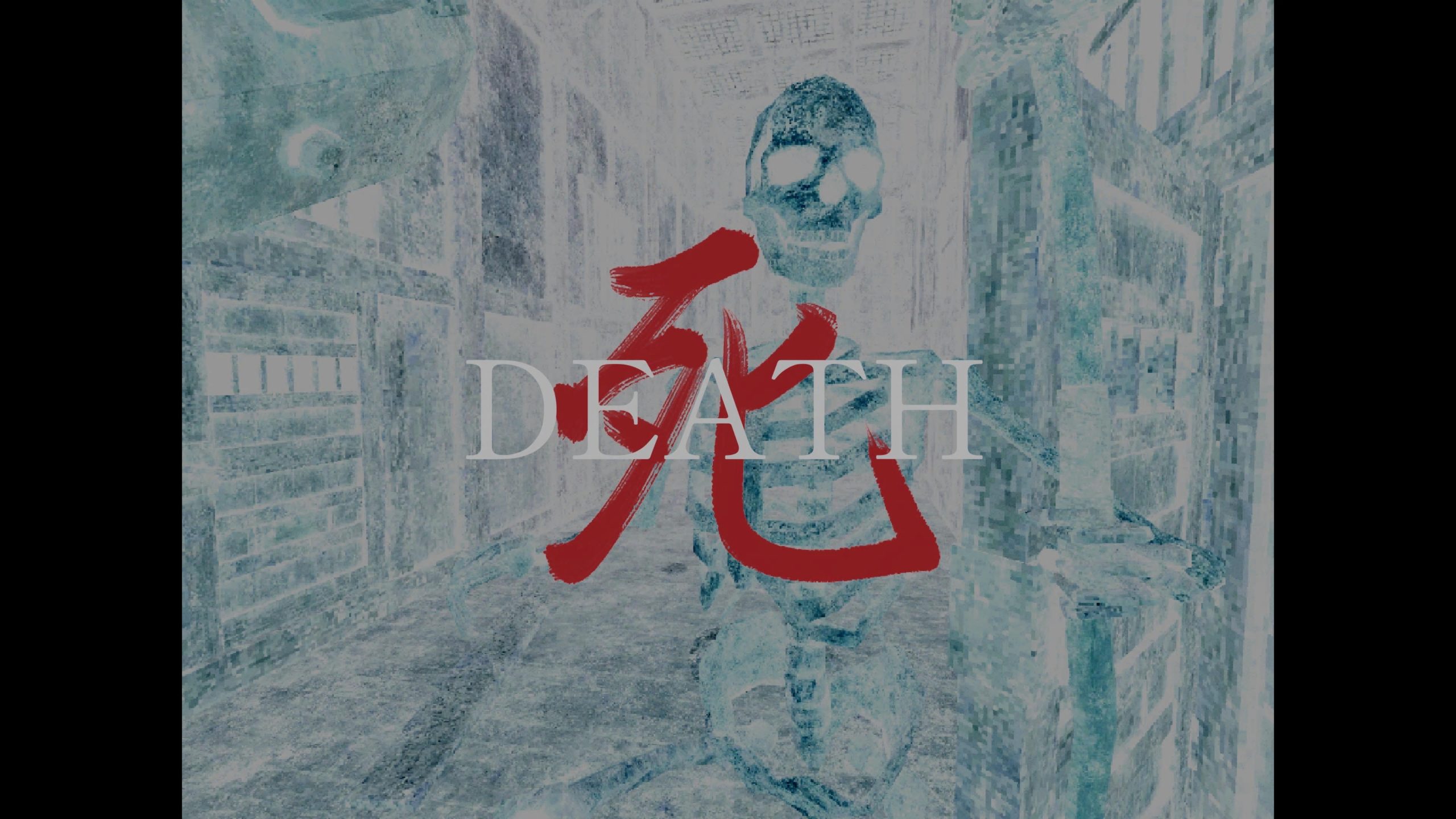As I trudge downhill to my nightmare, clanking from my armour and the disorienting ambience of Labyrinth of the Demon King’s soundtrack echoes through the fog. A familiar discomfort creeps in, one much like Silent Hill 2’s restless dream. There are audio/visual parallels between the two that would make any survival horror fan’s hair stand up on their neck; the 4:3 aspect ratio, the grungy overdetail in the environments that almost looks like static, and above all else, a crushing sense of tension – like the moments of terror that catch you holding your breath until you’re gasping for air.
However, we’re not in an eerie town similar to America’s Midwest in the ’90s, but rather a version of Feudal Japan that’s so dire, demons have manifested and plague the land. It’s inherently nostalgic, taking inspiration from the aforementioned Silent Hill 2, but also Resident Evil 2, Forbidden Siren, Fatal Frame, and even From Software’s debut, King’s Field, to spur on the feeling of games’ past.
Like those comparisons, the game is hard; so hard I almost gave up a couple of times. This’ll be the last comparison to a soulslike I’ll make for Labyrinth of the Demon King, but like From Software’s recent outputs, this game is overtly obtuse. You don’t get to play on your terms; you either fit in or let the legions of undead enemies unceremoniously kill you. Hardcore is on the Steam page’s description for the game, and hardcore just about sums it up. Labyrinth is a first-person melee-oriented dungeon crawler. You start with a small health bar, an even smaller stamina bar and a half-functioning, broken katana to start you off on your journey. But what journey is this? One about revenge.

Panned Labyrinth
You play as the last living footsoldier of Lord Takeda Nobumitsu’s clan. The Lord in question, has been killed by the titular Demon King in an ambush. The Demon King has scurried back to its stronghold, and you won’t find peace until the demon is slain, so you descend into a dark cave to infiltrate his whereabouts and thus starts the framework of the game.
The story itself is light on any overt storytelling. Instead, you’ll be reading a bunch of scrolls, interacting with some of the not-so-evil demons imprisoned in the stronghold, with a couple of cutscenes to give some visual finesse to some of the more grizzly moments the game has to offer. It’s a simple tale of revenge, one that uses the setting of Feudal Japan more like set dressing than something thematically compelling.
It’s good at setting the tone and atmosphere, but I found myself involved in the game mechanically more than anything else. I managed to beat the game in about 10 hours, and outside of some operative moments of dialogue that help you solve some of its puzzles in the early game, I could already see where the game was going in one or two ways, and sadly, it took the less interesting path.
Don’t get me wrong, the setting lends itself to feeling like a distinct entry in the survival horror/dungeon crawling genre, and one that’s steeped in atmosphere, but its overall narrative is lacklustre.

Horrible Histories
Thankfully, the gameplay is quite engaging to offset some of my narrative woes. Labyrinth of the Demon King borrows the best and worst elements from some of the games I’ve mentioned as influences. Whether that’s cut scenes of doors when you’re entering a room, being consistently chased by a hulking, unkillable demon Mr. X style, or fighting tooth and nail to scavenge health items in what feels like a deliberate and oppressive charge into hell, it’s all quite nostalgic whilst evoking a new flavour of dread.
This is largely due to its masterfully rigid combat system. Your movements are slow, so your outputs have to be intentional. You swing your weapon of choice with ‘R2’ or hold it and let go for a heavy attack, but you also have a dodge and a block and riposte system that’s frustratingly exact. A false move could mean your life, as your aforementioned health bar is slight, and every offensive move is at the cost of your stamina.
It was a steep learning curve to come out of combat encounters – in which there are many – relatively unscathed. Certain weapons have a damage type like slash or blunt, with some enemies being resistant to one or the other. These are things you’ll learn when you read some of the games’ texts, but if you’re not as methodical in your searching, you won’t be as fruitful in your fighting. Each weapon has its own move sets for you to learn too, though whilst they’re a nice addition, I never found myself ever really using them.

By My Blade
My thoughts on the combat are something I’ve had to wrestle with. There were moments where I thought the game was being totally unfair, like say if more than one enemy comes at you, but with time, patience and perseverance, you come to learn some of the game’s unspoken intricacies. I could easily wave it off as “jank”, and in some respect, it is. But I think if it’s fully what the developer intended, then it’s more of a risky design choice.
Some people will get themselves in the first couple of scraps and write it off, however, there will be a core audience that’ll stick by these choices and come to appreciate them just as I have in my 10 or so hours of playing. I’d be less forgiving if it meant that Labyrinth of the Dragon King was unplayable, but it’s not; there are even some instances where these design choices work in your favour.
These moments reside more in the boss fights, as I found myself kind of gaining the system to have some combat advantage. You can sprint in the game at no cost to stamina, however, sprinting means you won’t regain any either. So for boss fights, I would run around them swinging until I was out of stamina, then eat a mushroom, which would instantly replenish it and repeat.
It led me to find the boss battles less interesting in comparison to the rest of the game, but legitimately fighting the bosses will prove a real challenge. Like the nostalgic horrors of the PS1 era, Labyrinth of the Demon King lets you open up the menus will pause the game, giving you infinite time to heal up, maybe change weapon depending on the combat scenario, or just generally catch your breath.
In The Belly of the Beast
As the name of the game suggests, this haunted house style ancient castle is labyrinthian. Hallways are claustrophobic and winding, rooms are bigger but shrouded in darkness, and the soundscape is anxiety-inducing. Metal thuds, whaling drones and the snarls and shrieks of demons keep you on your toes as to when you may need to engage in combat, but I never quite found my footing due to its maze-like design.
It’s difficult to navigate through the castle, even with the help of a map, because there are just so many pathways and rooms to look through in fear. This plays into how the puzzles are managed in the game too. For the most part, it’s your standard affair of finding key items that relate to a locked door, which you’ll find out of order. This provides a lot of backtracking, and even then, I would still find myself lost.
There was one standout puzzle that saw me turning these statues of different figures that were being hanged. Each had their own assigned character that relates to a story you’ll read in the room. This had me inspecting each one to find out who they were, conflating it with the story and following the order that it plays out in to get the key item.
However, the rest of the puzzle is more a case of the right key item, in the wrong room and going back and forth until you can proceed forward. It’s incredibly indicative of survival horror and leans into a classic formula a little too much for my liking, but the oppressive act of simply traversing across the castle distracts you from its simplicity.

No Seppuku For You
It’s fair to say there’s a level of atmosphere in Labyrinth of the Demon King that sets it apart from its peers who are attempting PS1-style horror. That and its unique approach to gameplay via first-person melee combat instead of a fixed camera or over-the-shoulder is an unnerving new perspective to experience. The setting, too, whilst maybe a little shallow once the initial thrills wear off, is still a version of Feudal Japan I’ll only revisit if there’s ever a sequel, or if I want to punish myself and replay this.
Nostalgia plays an important part in my enjoyment of the game, though. If I didn’t get the stylistic references to the handful of games I love, would this hit as hard? It then makes me think of the people who may want to jump in because it’s a “new” game and could probably fall in love with its bleak and crushing world and gameplay, which would excite players to look back at what helped influence this.
Labyrinth of the Demon King is niche and is good in that corner for fans of the genre. However, I don’t know if its intimidating exterior keeps its cool when unpacking the narrative or puzzle design for me to love this as a survival horror or a hardcore dungeon crawler. I’m just glad I made it out of the labyrinth in one piece.
Labyrinth of the Demon King is out now for PlayStation 5/4 (review platform), Xbox, Nintendo Switch and PC via Steam.
Developers: J. R. Hudepohl
Publisher: Top Hat Studios
Disclaimer: In order to complete this review, we were provided with a promotional copy of the game. For our full review policy, please go here.
If you enjoyed this article or any more of our content, please consider our Patreon.
Make sure to follow Finger Guns on our social channels. Twitter, Facebook, Twitch, Spotify or Apple Podcasts – to keep up to date on our news, reviews and features.
